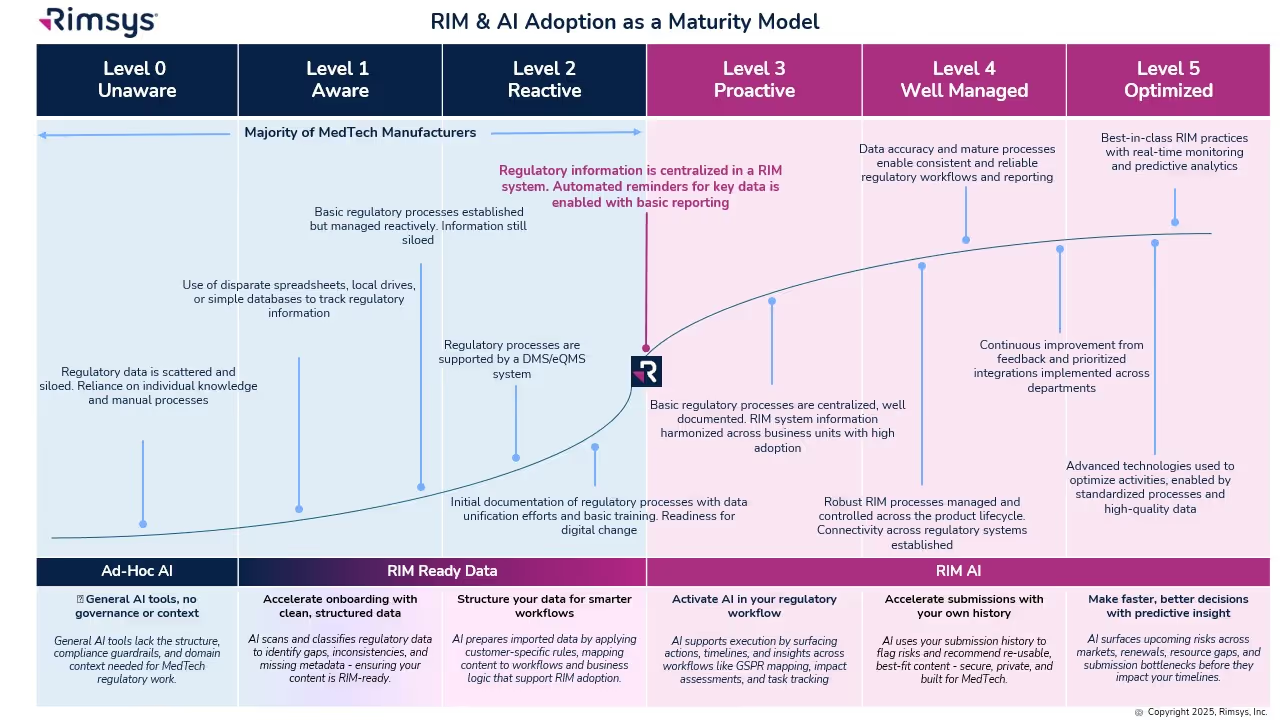Regulatory information management (RIM) systems and organizational change management

At first glance, the juxtaposition of RIM and change management seems a little strange. One is a software tool and the other a management discipline, but one of the things we’ve seen across RIM deployments is that it’s difficult to have one without the other. For many regulatory affairs teams, a RIM system isn’t simply a tool, it’s a digital transformation. This means that there’s a broader set of organizational considerations and actions that need to surround the implementation of a RIM system to ensure its success. Remember that 70% of digital transformation initiatives fail.
RIM systems are a disruptive technology
Disruptive? Really? Aren’t RIM systems supposed to streamline regulatory activities, and improve team productivity? Yes they definitely provide these benefits, but they also require a change in how the team works. Most RIM implementations aren’t replacing existing software, they’re replacing manual processes. In our experience, Rimsys is displacing registrations that are managed via spreadsheets, and sometimes even paper-based processes.
This means that the way that teams have managed processes is changing significantly. While it’s likely that teams are struggling to operate effectively (there’s usually some organizational pain that leads to a RIM evaluation), there’s also discomfort with the change. RA team members are proficient in their work, they know how to get things done, and likely have systems they’ve created to cope with the inefficiencies in their current processes.
Regardless of department or industry, automation initiatives can lead to employees feeling threatened with obsolescence, lacking direction, and afraid of being replaced. In medtech regulatory affairs this is rarely the case. Most companies have to invest heavily in external consultants just to keep pace with the current workload. In fact, large medtech companies regularly outsource 50% or more of their regulatory activities. This doesn’t mean that team members won’t experience these insecurities. That’s why it’s important to have a change management strategy in place to support any RIM rollout.
A RIM change management strategy
All of these factors mean that RIM implementation that doesn’t have an accompanying change management strategy won’t see the same level of success, or deliver on expected outcomes. The good news is that there are a universal set of tactics to support effective change management that can be easily applied in this scenario. Here are 4 steps that you can take to lay the groundwork for a successful RIM implementation.
Step 1: start at the top
Teams that are in the process of acquiring a RIM system likely already have leadership support, but it’s important that your senior leaders have a visible presence in the process. This means issuing communications, participating in kick-off meetings, and being available to answer questions. This applies both to RA leaders and those in adjacent departments like QA and IT as well.
The visible support reinforces the idea that leadership teams are aligned and fully supportive of the changes taking place. It affirms that RIM is a strategic priority for the company, and helps to alleviate any fear or anxiety about the change. Leadership support also helps to signal to teams that they’ll be supported as they go through the implementation process, and that work will be prioritized.
Step 2: communicate early and often
RA teams are busy—often very busy. This is typically why a RIM system is being implemented in the first place. However, when teams are really busy, it’s really easy for communications to fall through the cracks. This means that plans and timelines for a RIM implementation need to be communicated more than once.
Communications should emanate from leadership teams (see step 1), and be candid about coming changes, the reasons for them, and the expectations from team members as the project moves forward. Leaders should encourage communication that moves in both directions, and be open to feedback from team members. Companies should look to create channels for RA team members to reach out with any comments or concerns.
Step 3: strive to minimize disruption
While there’s no way to completely eliminate the disruption associated with a new RIM system—it will fundamentally change the way a RA team works there’s no way around it—there are ways to minimize disruption. There first part of this is making sure you’re communicating enough about the project (see step 2). Team members are much more receptive to change if they aren’t blindsided by it.
It’s also helpful to take steps to make sure that team members have an opportunity to learn about the RIM systems throughout the acquisition and implementation process. Bring team members into product demonstrations, and let them ask questions about solutions that are being evaluated. Don’t wait to run training sessions until the RIM system is fully implemented. These can run in parallel. With this approach the whole team feels invested in the solution, and is fully ramped to start running at the end of implementation.
Step 4: lay the groundwork for continuous improvement
This article discusses change management from the perspective of a discrete event—the acquisition and implementation of a RIM system. However, RA teams shouldn’t look at change as something with fixed start and end, but rather as something continuous. RIM systems today represent one way that RA teams can embrace digitization and automation to improve how they work. There will be many additional opportunities as regulations, regulatory bodies, and technology evolve.
In recent years we’ve seen an expansion of UDI requirements for medical devices across markets. We’ve seen more stringent requirements for post-market surveillance. And we’ve seen the growing adoption of digital pathways for regulatory submissions and other interactions with health authorities. For many teams, a successful RIM implementation is just the first step on what will be a broader organizational transformation.
Successful changes for RIM and beyond
RIM systems can provide enormous benefits to RA teams, but only if they’re fully implemented and adopted. While deep in the weeds of requirements gathering and vendor evaluations it’s easy to overlook the fact that moving from traditionally manual processes to automated ones in a RIM system represents a significant organizational change. As a part of any RIM acquisition initiative, teams should fully understand their change management needs, and take steps to address them in concert with software selection.
Having teams fully onboard and supportive of the initiative makes them much more likely to adopt the final solution. Engaging in this way also allows you to plan for, and prioritize the resources needed for the implementation phase—leading to faster time to value for the project. Ultimately organizational change will and should be something that RA teams are comfortable with. The practices adopted with a RIM implementation can be used to support future digitization and automation across all RA activities.
To learn more best practices around RIM sourcing and implementation including an organizational self-assessment, detailed overview of capabilities, and a worksheet you can use for vendor evaluations, check out our RIM Buyer’s Guide for MedTech Companies.
Similar posts







.avif)

